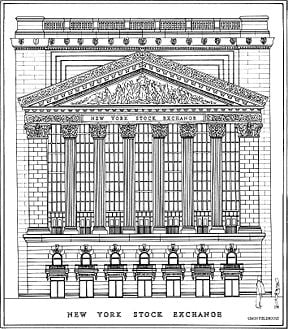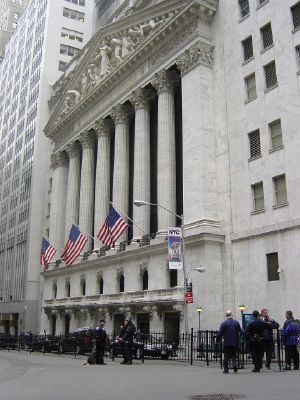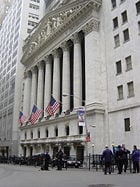Difference between revisions of "New York Stock Exchange" - New World Encyclopedia
m (Robot: Remove claimed tag) |
|||
| Line 143: | Line 143: | ||
*[http://www.marketwatch.com/News/Story/Story.aspx?guid=%7B1FA12791-0B41-436C-AD86-7E7E61B967F9%7D&siteid=mktw Price of membership and a seat] | *[http://www.marketwatch.com/News/Story/Story.aspx?guid=%7B1FA12791-0B41-436C-AD86-7E7E61B967F9%7D&siteid=mktw Price of membership and a seat] | ||
| − | |||
{{Registered Historic Places}} | {{Registered Historic Places}} | ||
Revision as of 23:30, 28 December 2008
- This article is about the stock exchange itself. For its parent company, see NYSE Euronext.
| New York Stock Exchange | |||
|---|---|---|---|
| NYSE Logo | |||
| 200px | |||
| Type | Stock Exchange | ||
| Location | |||
| Coordinates | coord}}{{#coordinates:40|42|24|N|74|00|41|W|region:US-NY_type:landmark | name=
}} | |
| Owner | NYSE Euronext | ||
| Key people | John A. Thain (CEO) | ||
| Currency | USD | ||
| No. of listings | 2,773 | ||
| MarketCap | USD 25 trillion (2006) | ||
| Volume | USD 21 trillion (2006) | ||
| Indexes | NYSE Composite Index Dow Jones Industrial Average | ||
| Website | www.nyse.com | ||
(HABS photo)
The New York Stock Exchange (NYSE), nicknamed the "Big Board," is a New York City-based stock exchange. It is the largest stock exchange in the world by dollar volume and, with 2,764 listed securities[1], has the second most securities of all stock exchanges. Its share volume was exceeded by that of NASDAQ during the 1990s. As of December 31, 2006, the combined capitalization of all New York Stock Exchange listed companies was $25.0 trillion. [2]
The NYSE is operated by NYSE Euronext, which was formed by its merger with the fully electronic stock exchange Archipelago Holdings and Euronext. The New York Stock Exchange trading floor is located at 11 Wall Street, and is composed of four rooms used for the facilitation of trading. A fifth trading room, located at 30 Broad Street, was closed in February 2007. The main building, located at 18 Broad Street between the corners of Wall Street and Exchange Place, was designated a National Historic Landmark in 1978.[3]
NYSE Group merged with Euronext, and many of its operations (particularly IT and the trading platform) will be combined with that of the New York Stock Exchange and NYSE Arca.
Business
The New York Stock Exchanges provides an efficient method for buyers and sellers to trade shares of stock in companies registered for public trading. The exchange provides price discovery via an auction environment designed to produce the fairest price for both parties. Since September 30, 1985 the NYSE trading hours have been 9:30–4:00 ET. (As of February 9, 2007, the streetTRACKS Gold Shares ETF started its trading day on the NYSE at 8:20 AM.)
As of January 24, 2007, all NYSE stocks can be traded via its electronic Hybrid Market (except for a small group of very high priced stocks). Customers can now send orders for immediate electronic execution, or route orders to the floor for trade in the auction market. In excess of 50% of all order flow is now delivered to the floor electronically.
On the trading floor, the NYSE trades in a continuous auction format. Here, the human interaction and expert judgment as to order execution differentiates the NYSE from fully electronic markets. There is one specific location on the trading floor where each listed stock trades. Exchange members interested in buying and selling a particular stock on behalf of investors gather around the appropriate post where a specialist broker, who is employed by a NYSE member firm (that is, he/she is not an employee of the New York Stock Exchange), acts as an auctioneer in an open outcry auction market environment to bring buyers and sellers together and to manage the actual auction. They do on occasion (approximately 10% of the time) facilitate the trades by committing their own capital and as a matter of course disseminate information to the crowd that helps to bring buyers and sellers together. The frenzied commotion of men and women in colored smocks has been captured in several movies, including Wall Street.
In the mid-1960s, the NYSE Composite Index (NYSE: NYA) was created, with a base value of 50 points equal to the 1965 yearly close, to reflect the value of all stocks trading at the exchange instead of just the 30 stocks included in the Dow Jones Industrial Average. To raise the profile of the composite index, in 2003 the NYSE set its new base value of 5,000 points equal to the 2002 yearly close. (Previously, the index had stood just below 500 points, with lifetime highs and lows of 670 points and 33 points, respectively.)
The right to directly trade shares on the exchange is conferred upon owners of the 1366 "seats." The term comes from the fact that up until the 1870s NYSE members sat in chairs to trade; this system was eliminated long ago. In 1868, the number of seats was fixed at 533, and this number was increased several times over the years. In 1953, the exchange stopped at 1366 seats. These seats are a sought-after commodity as they confer the ability to directly trade stock on the NYSE. Seat prices have varied widely over the years, generally falling during recessions and rising during economic expansions. The most expensive seat was sold in 1929 for $625,000, which, adjusted for inflation, is over six million in today's dollars. In recent times, seats have sold for as high as $4 million in the late 1990s and $1 million in 2001. In 2005, seat prices shot up to $3.25 million as the exchange was set to merge with Archipelago and become a for-profit, publicly traded company. Seat owners received $500,000 cash per seat and 77,000 shares of the newly formed corporation. The NYSE now sells one-year licenses to trade directly on the exchange.
History
| New York Stock Exchange | |||
|---|---|---|---|
| (U.S. National Historic Landmark) | |||
| | |||
| Location: | New York, NY | ||
| Coordinates: | coord}}{{#coordinates:40|42|24.21|N|74|0|41.6|W| | name=
}} | |
| Built/Founded: | 1903 | ||
| Architect: | Trowbridge & Livingston; George B. Post | ||
| Architectural style(s): | Classical Revival | ||
| Added to NRHP: | June 02, 1978[4] | ||
| Reference #: | 78001877 | ||
| Governing body: | Private | ||
The origin of the NYSE can be traced to May 17, 1792, when the Buttonwood Agreement was signed by twenty-four stock brokers outside of 68 Wall Street in New York under a buttonwood tree. On March 8, 1817, the organization drafted a constitution and renamed itself the "New York Stock & Exchange Board." (This name was shortened to its current form in 1863.) Anthony Stockholm was elected the Exchange's first president.
The first central location of the NYSE was a room rented for $200 a month in 1817 located at 40 Wall Street. But the volume of stocks traded had increased sixfold in the years between 1896 and 1901 and a larger space was required to conduct business in the expanding marketplace.[5] Eight New York City architects were invited to participate in a design competition for a new building and the Exchange selected the neoclassic design from architect George B. Post. Demolition of the existing building at 10 Broad Street and the adjacent lots started on 10 May 1901.
The New York Stock Exchange building opened at 18 Broad Street on April 22 1903 at a cost of $4 million. The trading floor was one of the largest volumes of space in the city at the time at 109 x 140 feet (33 x 42.5 m) with a skylight set into a 72-foot (22 m) high ceiling. The main façade of the building features marble sculpture by John Quincy Adams Ward in the pediment, above six tall Corinthian capitals, called “Integrity Protecting the Works of Man.” The building was listed as a National Historic Landmark and added to the National Register of Historic Places on June 2, 1978.[6]
In 1922, a building designed by Trowbridge & Livingston was added at 11 Broad Street for offices, and a new trading floor called "the garage." Additional trading floor space was added in 1969 and 1988 (the "blue room") with the latest technology for information display and communication. Another trading floor was opened at 30 Broad Street in 2000. With the arrival of the Hybrid Market, a greater proportion of trading was executed electronically and the NYSE decided to close the 30 Broad Street trading room in early 2006.
The 11 Wall Street building was designated a National Historic Landmark in 1978.[7],[8],[9]
Events
The Exchange was closed shortly after the beginning of World War I (July 1914), but it re-opened on November 28 of that year in order to help the war effort by trading bonds.
On September 16, 1920, a bomb exploded on Wall Street outside the NYSE building, killing 33 people and injuring more than 400. The perpetrators were never found. The NYSE building and some buildings nearby, such as the JP Morgan building, still have marks on their facades caused by the bombing.
The Black Thursday crash of the Exchange on October 24, 1929, and the sell-off panic which started on Black Tuesday, October 29, are often blamed for precipitating the Great Depression. In an effort to try to restore investor confidence, the Exchange unveiled a fifteen-point program aimed to upgrade protection for the investing public on October 31, 1938.
On October 1, 1934, the exchange was registered as a national securities exchange with the U.S. Securities and Exchange Commission, with a president and a thirty-three member board. On February 18, 1971 the not-for-profit corporation was formed, and the number of board members was reduced to twenty-five.
On October 19, 1987, the Dow Jones Industrial Average (DJIA) dropped 554.26 points, a 22.6% loss in a single day, the biggest one-day drop the exchange had yet experienced, prompting officials at the exchange to invoke for the first time the "circuit breaker" rule to halt all trading. This was a very controversial move and led to a quick change in the rule; trading now halts for an hour, two hours, or the rest of the day when the DJIA drops 10, 20, or 30 percent, respectively. In the afternoon, the 10% and 20% drops will halt trading for a shorter period of time, but a 30% drop will always close the exchange for the day. The rationale behind the trading halt was to give investors a chance to cool off and reevaluate their positions. As a matter of fact, Black Monday was followed by Terrible Tuesday, a day in which the Exchange's systems did not perform well and some people had difficulty completing their trades.
There was a panic similar to many with a fall of 7.2% in value on October 27, 1997 prompted by falls in Asian markets, from which the NYSE recovered quickly.
The NYSE was closed from September 11 until September 17, 2001 as a result of the September 11, 2001 attacks.
On September 17, 2003, NYSE chairman and chief executive Richard Grasso stepped down as a result of controversy concerning the size of his deferred compensation package. He was replaced as CEO by John S. Reed, the former Chairman of Citigroup.
The NYSE announced its plans to acquire Archipelago on April 21, 2005, in a deal intended to reorganize the NYSE as a publicly traded company. NYSE's governing board voted to acquire rival Archipelago on December 6, 2005, and become a for-profit, public company. It began trading under the name NYSE Group on March 8, 2006. A little over one year later, on April 4, 2007, the NYSE Group completed its merger with Euronext, the European combined stock market, thus forming the NYSE Euronext, the first transatlantic stock exchange.
Presently, Marsh Carter is Chairman of the New York Stock Exchange, having succeeded John S. Reed. John Thain is the CEO of the NYSE while Gerald Putnam and Catherine Kinney are the co-Presidents.
Chronology
| ||||||||||
Wikimedia Commons has media related to:
| ||||||||||
{{#invoke:Message box|ambox}}
- 1792 - The NYSE acquires its first traded company[citation needed]
- 1817 - The constitution of the New York Stock and Exchange Board is drafted[citation needed]
- 1867 - The First Stock Ticker [1]
- 1896 - Dow Jones Industrial Average (DJIA) first published in The Wall Street Journal[citation needed]
- 1903 - NYSE moves into new quarters at 18 Broad Street
- 1907 - Panic of 1907
- 1914 - World War I causes the longest exchange shutdown: four months, two weeks
- 1915 - Market price is given in dollars
- 1929 - Central quote system established; Black Thursday (October 24) and Black Tuesday (October 29) signal coming of Great Depression
- 1943 - Trading floor is opened to women [10]
- 1949 - Longest bull market begins[citation needed]
- 1954 - DJIA surpasses its 1929 peak
- 1966 - NYSE creates the Common Stock Index; floor data fully automated[citation needed]
- 1970 - Securities Investor Protection Corporation established
- 1971 - NYSE recognized as Not-for-Profit organization for tax purposes [citation needed]
- 1972 - DJIA closes above 1,000
- 1977 - Foreign brokers are admitted to NYSE
- 1979 - New York Futures Exchange established
- 1987 - Black Monday, October 19, sees the largest one-day DJIA percentage drop
- 1991 - DJIA exceeds 3,000
- 1996 - Real-time ticker introduced[citation needed]
- 1999 - DJIA exceeds 10,000
- 2000 - First NYSE global index launched under the ticker NYIID
- 2001 - Trading in fractions (n/16) ends, replaced by decimals (increments of $.01, see Decimalisation); September 11, 2001 attacks occur, closing NYSE for 4 sessions
- 2003 - NYSE Composite Index relaunched and value set equal to 5,000 points
- 2006 - NYSE and ArcaEx merge, forming the publicly owned, for-profit NYSE Group, Inc.; in turn, NYSE Group merges with Euronext, creating the first trans-Atlantic stock exchange group; DJIA tops 12,000 on October 19
- 2007 - US President George W. Bush shows up unannounced to the Floor about an hour and a half before an FOMC interest-rate decision on January 31. [11]; NYSE Composite closes above 10,000 on June 1; DJIA closes above 14,000 on July 19
Notes
- ↑ New York Stock Exchange > Listed Securities - Retrieved December 19, 2007.
- ↑ New York Stock Exchange Fact Book - Retrieved December 19, 2007.
- ↑ National Park Service, National Historic Landmarks Survey, New York - Retrieved December 19, 2007.
- ↑ National Register Information System - Retrieved December 19, 2007.
- ↑ The Building - Retrieved December 19, 2007.
- ↑ National Register Number: 78001877 - Retrieved December 19, 2007.
- ↑ Cite error: Invalid
<ref>tag; no text was provided for refs namednhlsum - ↑ "New York Stock Exchange" - Retrieved December 19, 2007.
- ↑ New York Stock Exchange—Accompanying 7 photos, exterior, from c.1955 to 1976. - Retrieved December 19, 2007.
- ↑ NYSE: Timeline - Retrieved December 19, 2007.
- ↑ President Bush makes surprise visit to NYSE - Retrieved December 19, 2007.
External links
All links retrieved December 19, 2007.
- New York Stock Exchange website
- NYSE Valuations
- Archived collection of NYSE Transformation
- Price of membership and a seat
Template:Registered Historic Places
Credits
New World Encyclopedia writers and editors rewrote and completed the Wikipedia article in accordance with New World Encyclopedia standards. This article abides by terms of the Creative Commons CC-by-sa 3.0 License (CC-by-sa), which may be used and disseminated with proper attribution. Credit is due under the terms of this license that can reference both the New World Encyclopedia contributors and the selfless volunteer contributors of the Wikimedia Foundation. To cite this article click here for a list of acceptable citing formats.The history of earlier contributions by wikipedians is accessible to researchers here:
- York Stock Exchange&oldid=166370694 New York Stock Exchange York Stock Exchange&action=history history
The history of this article since it was imported to New World Encyclopedia:
Note: Some restrictions may apply to use of individual images which are separately licensed.





